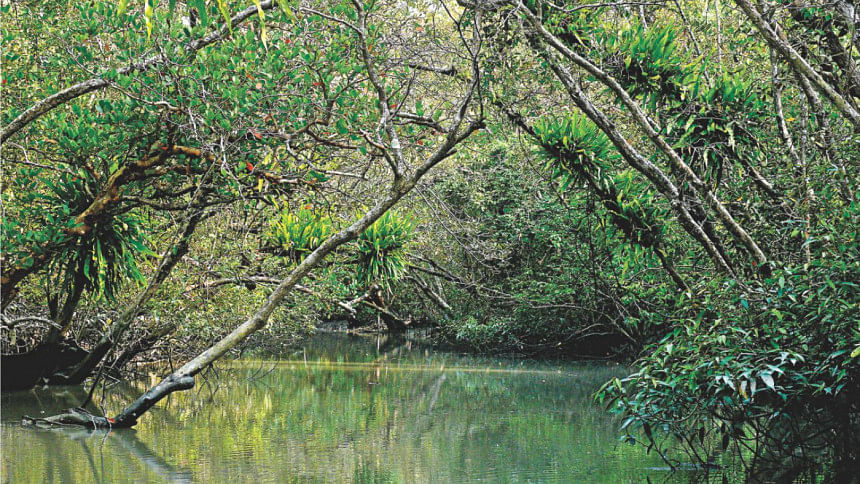A Paradise in Peril

Photo: Sayam U. Chowdhury
In the magical mangrove forest of the Sundarbans roams one of the world's most majestic creatures. It is so elusive and ferocious that it is venerated as the king or 'God' in the localities around the forest. Thousands of myths have been created based on it, making it one of the most legendary creatures of the world. It is the Bengal Tiger, one of the most endangered tiger species, declared by International Union for the Conservation of Nature.
Although Bengal Tigers can be found in some of the tropical forests in India, Myanmar, Bhutan and Nepal, the type that lives in the mangrove swamps of the Sundarbans is very special. These are the only tigers in the world which live in a mangrove forest. Its superb adaptation has made it the most skilled hunter in one of the most inhospitable lands of the world. In the Sundarbans, where saline water inundates the land twice a day and thorny aerial roots covers the forest floor, the tiger moves about stealthily to look for its prey.
Today, on 29th of July, the International Tiger Day, many Bangladeshis are worried about the survival of this tiger which is their national animal. As of 2004, the tiger population estimated in the Bangladeshi part of the Sundarbans was four hundred and forty. However, according to the India-Bangladesh Joint Tiger Census Project Report published in July 2015, the tiger population in the Bangladeshi part of the Sundarbans was estimated to be only one hundred and six.

According to experts from WildTeam, an organisation which has been working for the conservation of Bengal Tigers in the Sundarbans, some parts of the Sundarbans which are mostly near to Khulna can be called 'tiger empty regions'. The most significant threat to the existence of this big cat is illegal trade of tiger skins and body parts which are highly priced all over the world. Particularly the demand of tiger body parts in traditional Chinese medicine has accelerated the poaching of the Bengal tiger.
According to Bangladesh's forest department data, from 2001-2014, at least 49 tigers have been killed; however the census report reveals that the actual number might be a lot more than that. On the other hand, the tiger's main prey- the spotted deer- are also hunted frequently in the Sundarbans. In the tiger census report of 2015, it has been estimated that every year 10,000 deer are consumed as meat in Bangladesh, which is a major cause of the declination of tiger's prey in the forest.
Simultaneously, loss of habitat is also one of the most significant threats to the tigers' existence in Bangladesh. A male Bengal tiger, being a very solitary and territorial creature, needs to patrol on an average 12-14 square kilometres area of forest as his territory. As a result, deforestation and human intrusion significantly affects the Bengal tiger's existence in the Sundarbans. According to a study of Food and Agricultural Organisation in 2009, Bangladesh loses 2000 hectares of forest per year that mostly affects the Sundarbans, which has been declared as a UNESCO World Heritage Site in 1997.
Besides, in 2010 an MoU was signed between Bangladesh Power Development Board and India's state owned National Thermal Power Corporation to build the coal fired 1320 MW Rampal Power Station in 1834 acres of land which is only 14 kilometre north of the Sundarbans. In July 13, 2016 the government signed the agreement to begin the main construction of the power plant. According to environmentalists and conservationists all over the world, this power plant will significantly affect not only the flora and fauna of the Sundarbans, but it will also create adverse impacts on the four million poverty ridden people, whose livelihood largely depends on this coastal forest.

Alasdair Harris PhD. conservationist and founder of Blue Ventures told the Star Weekend, "While Bangladesh has an urgent need for enhanced power generation capacity to meet the needs of its rapidly growing and underserved population, the proposed Rampal development raises serious concerns for the Sundarbans' ecosystem. Above and beyond the Sundarbans' global importance for biodiversity conservation, this unique 'blue forest' ecosystem plays a critical role safeguarding the resilience of Bangladesh's vulnerable coastal communities - underpinning fisheries and traditional livelihoods that are critical to the food security, income and cultures of millions of people, while also providing a natural barrier to protect coastal regions from the impacts of climate change."
"Ironically, disruption of this globally important carbon sink through development for the plant will only serve to hasten the human induced greenhouse warming that is already threatening its future, and that of coastal areas throughout Bangladesh," he adds.
Citizens from all walks of life and the civil society, along with experts, have also protested against this project as it will increase human intrusion into the forest in an alarming rate. According to Professor Dr Abdullah Harun Chowdhury of Khulna University's Environmental Sciences Department, "Coal for this massive plant will be transported to the power station through smaller vessels which will navigate through the river channels flowing through the Sundarbans. There is possibility that poisonous bleaching water which carries heavy metals like led and beryllium from the coal will mix with the river water and spread all over the forest during high tides which will ultimately poison the forest floor.

"On the other hand, this coal based power plant will produce poisonous gases like Sulphur Dioxide and Carbon Monoxide. The government's environmental impact analysis report suggests that the amount of gas the plant will produce will not be harmful for the forest's flora and fauna. However, from summer to late autumn, the wind flows from north to south in that particular area of Bangladesh. As the plant is 14 kilometres north of the forest, the gasses produced by the plant, even the amount the government report mentioned, will significantly affect the forest climate and ecosystem" adds Professor Harun.
Another researcher and conservationist Mohammad Arju, who has been studying the navigation trend through the rivers of the Sundarbans from 2015 says, "Under 'Protocol on Inland Water Transit and Trade (PIWT&T)' between Bangladesh and India, from July 2008 to December 2014 a total of 8,47,060 metric tons of goods was carried through the rivers of the Sundarban."
"If coal powered plant with such a giant capacity starts operation here, vessels carrying coals from India will increase many times and threaten the balance of the swamp forest even without the already occurring accidents like dumping oil or fly ash into the rivers," he adds.
However, Md Yunus Ali, Chief Conservator of Forest, Forest Department of Bangladesh government's Ministry of Environment and Forest says, "Pashur River has been dredged massively so that mother vessels can supply the coal to the power plant directly. So, river channels that flow through the Sunderbans will not be used by the coal carrying vessels.
"Besides, Bangladesh government has taken a lot of preventive measures so that no damage to the forest is done due to the power plant," he adds.
Despite such hopeful statements, scientists and conservationists are not that hopeful as, besides pollution, there is no doubt that massive, long term industrial projects like Rampal power station will also develop localities and create a lot of human activities near the forest that might decisively destroy the forest's fragile ecological balance.
"If the location of the plant cannot be changed, stringent social and environmental mitigation measures should be followed, to the highest global standards. These include a 'no net loss' policy on habitat destruction and forest cutting, stringent safeguards on water treatment and pollutants, rigorous and transparent monitoring and impact assessment, and broad-scale community engagement, including realistic livelihood diversification for those affected by the development," says Alasdair Harris.
However a question still remains of whether it is really possible to mitigate the environmental impacts of such a massive project which is being implemented in an extremely environmentally sensitive cyclone-prone area? If not, the long term adverse impacts of such industrial pollution will destroy the sanctity of the Sundarbans, its food chain will be broken, and the forest will be gradually destroyed. Thus, not only will we lose many of our priceless resources including our national pride, the Bengal Tiger, but also our survival on the mainland, which is highly dependent on the protection of this green belt from frequent cyclones, will be under a serious threat.

 For all latest news, follow The Daily Star's Google News channel.
For all latest news, follow The Daily Star's Google News channel. 



Comments